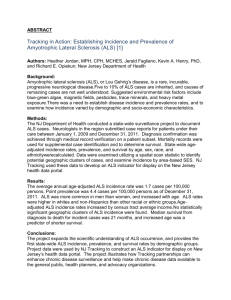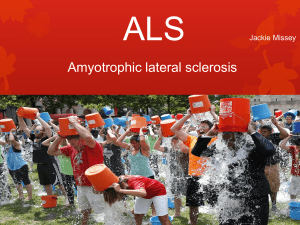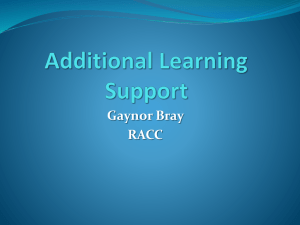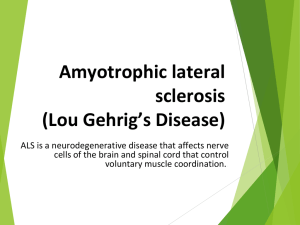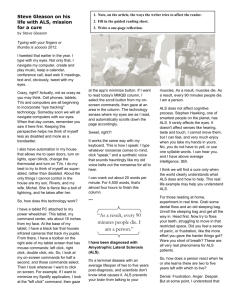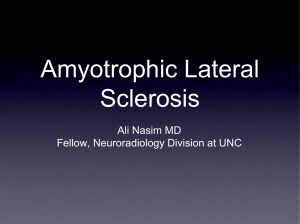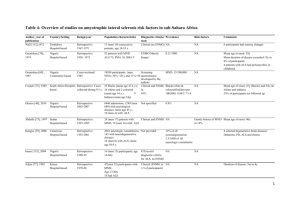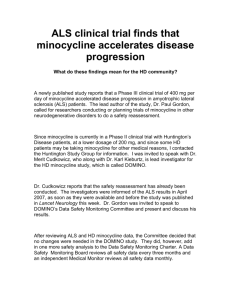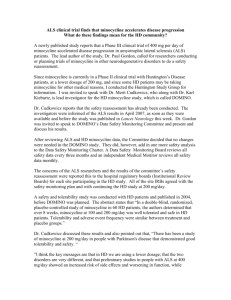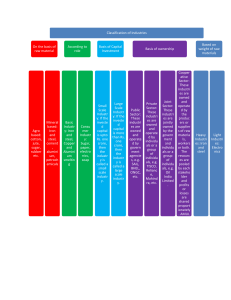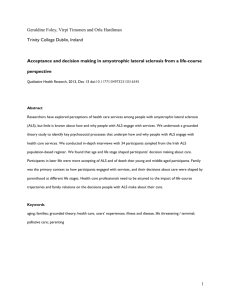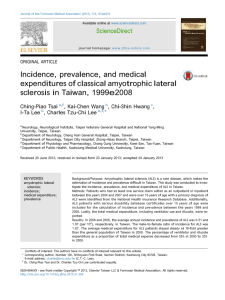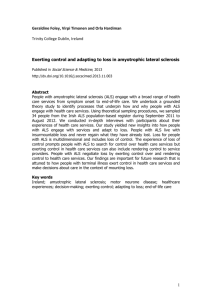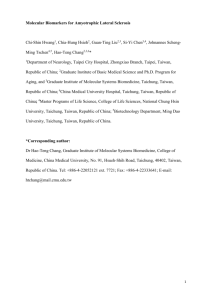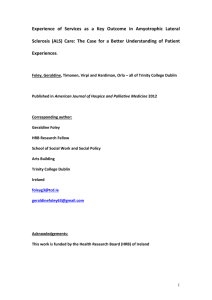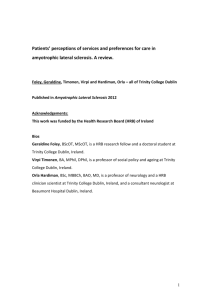Download: Media Alert - ALS cancer epidemiology
advertisement
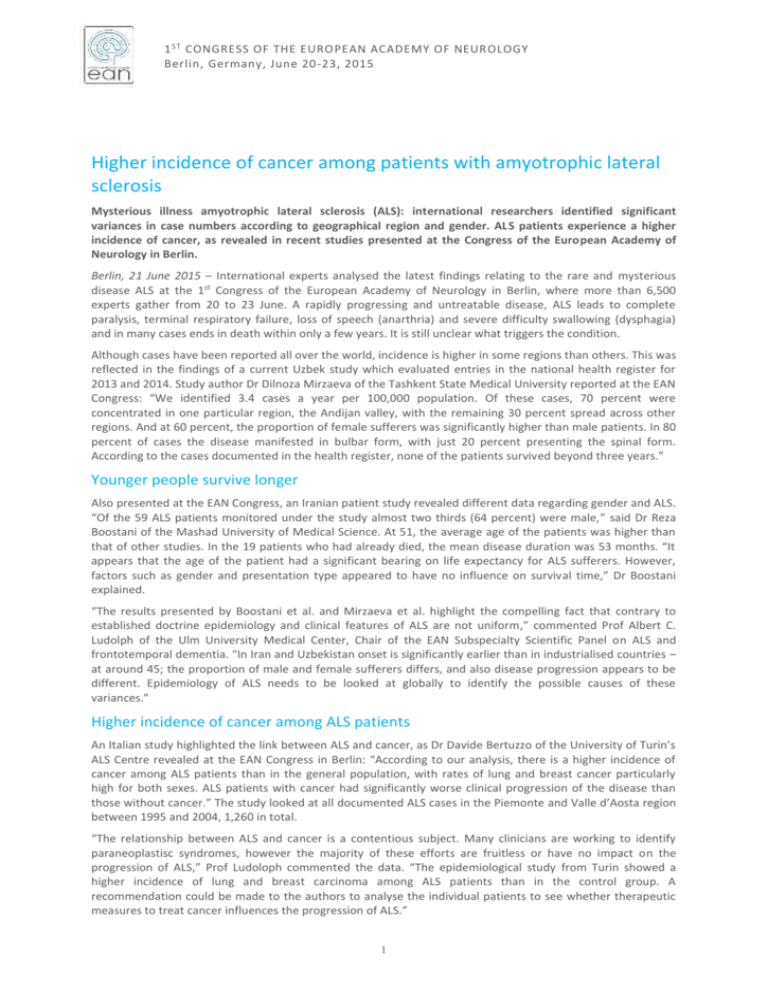
1 S T CONGRESS OF THE EUROPEAN ACADEMY OF NEUROLOGY Berlin, Germany, June 20 -23, 2015 Higher incidence of cancer among patients with amyotrophic lateral sclerosis Mysterious illness amyotrophic lateral sclerosis (ALS): international researchers identified significant variances in case numbers according to geographical region and gender. ALS patients experience a higher incidence of cancer, as revealed in recent studies presented at the Congress of the European Academy of Neurology in Berlin. Berlin, 21 June 2015 – International experts analysed the latest findings relating to the rare and mysterious disease ALS at the 1st Congress of the European Academy of Neurology in Berlin, where more than 6,500 experts gather from 20 to 23 June. A rapidly progressing and untreatable disease, ALS leads to complete paralysis, terminal respiratory failure, loss of speech (anarthria) and severe difficulty swallowing (dysphagia) and in many cases ends in death within only a few years. It is still unclear what triggers the condition. Although cases have been reported all over the world, incidence is higher in some regions than others. This was reflected in the findings of a current Uzbek study which evaluated entries in the national health register for 2013 and 2014. Study author Dr Dilnoza Mirzaeva of the Tashkent State Medical University reported at the EAN Congress: “We identified 3.4 cases a year per 100,000 population. Of these cases, 70 percent were concentrated in one particular region, the Andijan valley, with the remaining 30 percent spread across other regions. And at 60 percent, the proportion of female sufferers was significantly higher than male patients. In 80 percent of cases the disease manifested in bulbar form, with just 20 percent presenting the spinal form. According to the cases documented in the health register, none of the patients survived beyond three years.” Younger people survive longer Also presented at the EAN Congress, an Iranian patient study revealed different data regarding gender and ALS. “Of the 59 ALS patients monitored under the study almost two thirds (64 percent) were male,” said Dr Reza Boostani of the Mashad University of Medical Science. At 51, the average age of the patients was higher than that of other studies. In the 19 patients who had already died, the mean disease duration was 53 months. “It appears that the age of the patient had a significant bearing on life expectancy for ALS sufferers. However, factors such as gender and presentation type appeared to have no influence on survival time,” Dr Boostani explained. “The results presented by Boostani et al. and Mirzaeva et al. highlight the compelling fact that contrary to established doctrine epidemiology and clinical features of ALS are not uniform,” commented Prof Albert C. Ludolph of the Ulm University Medical Center, Chair of the EAN Subspecialty Scientific Panel on ALS and frontotemporal dementia. “In Iran and Uzbekistan onset is significantly earlier than in industrialised countries – at around 45; the proportion of male and female sufferers differs, and also disease progression appears to be different. Epidemiology of ALS needs to be looked at globally to identify the possible causes of these variances.” Higher incidence of cancer among ALS patients An Italian study highlighted the link between ALS and cancer, as Dr Davide Bertuzzo of the University of Turin’s ALS Centre revealed at the EAN Congress in Berlin: “According to our analysis, there is a higher incidence of cancer among ALS patients than in the general population, with rates of lung and breast cancer particularly high for both sexes. ALS patients with cancer had significantly worse clinical progression of the disease than those without cancer.” The study looked at all documented ALS cases in the Piemonte and Valle d’Aosta region between 1995 and 2004, 1,260 in total. “The relationship between ALS and cancer is a contentious subject. Many clinicians are working to identify paraneoplastisc syndromes, however the majority of these efforts are fruitless or have no impact on the progression of ALS,” Prof Ludoloph commented the data. “The epidemiological study from Turin showed a higher incidence of lung and breast carcinoma among ALS patients than in the control group. A recommendation could be made to the authors to analyse the individual patients to see whether therapeutic measures to treat cancer influences the progression of ALS.” 1 1 S T CONGRESS OF THE EUROPEAN ACADEMY OF NEUROLOGY Berlin, Germany, June 20 -23, 2015 Source: EAN-Abstracts Boostani et al, Epidemiology and clinical features of ALS in Iran; Mirzaeva et al, Epidemiological and clinical features of amyotrophic lateral sclerosis in Uzbekistan; Bertuzzo et al, ALS and Cancer: is there a link? EAN Press Office B&K – Bettschart&Kofler Kommunikationsberatung Dr Birgit Kofler Phone: +43 1 3194378; +49 172 7949286; +43 676 6368930 E-mail: kofler@bkkommunikation.com 2



